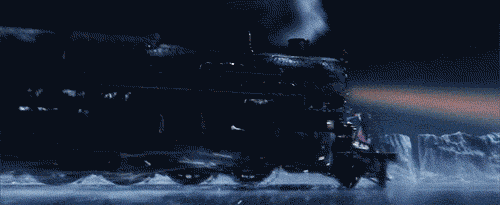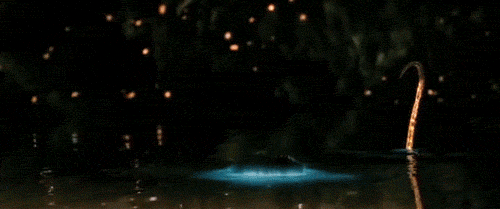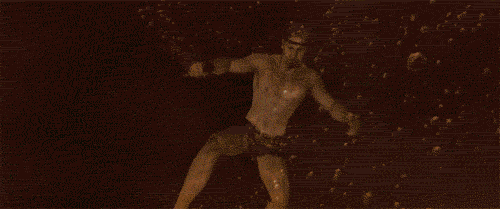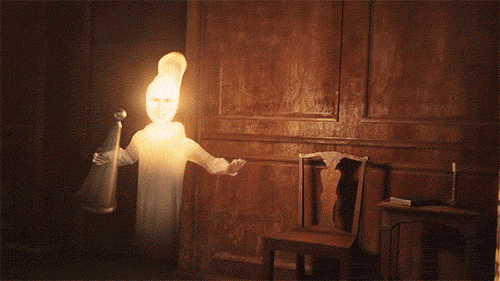5 Eye-Popping Reasons to Rewatch Robert Zemeckis's Motion-Capture Animated Movies
Just as Pablo Picasso had his Blue Period and Lars Von Trier went through his Dogme 95 Days, the first decade of the 21st century could be described as Robert Zemeckis’s Performance Capture Phase. Between 2004 and 2009, the Oscar-winning director of such blockbusters as Back to the Future, Forrest Gump and Cast Away abandoned live action filmmaking for a trilogy of features made using relatively new technology that married live performance with digital animation. Little could he have suspected that those three films — 2004’s The Polar Express, 2007’s Beowulf and 2009’s A Christmas Carol — would arguably become the most controversial titles in his filmography.
These days, performance capture (also known as motion capture or mo-cap) is a staple of blockbuster filmmaking, used in the creation of such memorable characters as ape king Caesar from the new Planet of the Apes series and the blue-skinned Na’vi from James Cameron’s Avatar. Back in 2004, though, mo-cap was still very new, having been given its most prominent showcase in 2002’s The Lord of the Rings: The Two Towers. On that film, director Peter Jackson collaborated with actor Andy Serkis to bring Gollum to raspy life. Suited up in a sensor-studded outfit studded, Serkis acted out the role on a soundstage in front of cameras that recorded his performance and provided the foundation for a digital character that would be further fleshed out by teams of animators. The performance aspect of performance capture is specifically what fascinated Zemeckis about the evolving technology. “I found in my big effects movies where I had to do a lot of major blue-screen work, it’s really hard to keep the energy from flattening out,” he told The New York Times prior to the release of The Polar Express. “Performance capture is different because it’s all about the acting.”
While Zemeckis was all in on mo-cap, others proved more skeptical. The sky-high price tag proved one factor. While The Polar Express earned close to $200 million during its run, Beowulf and A Christmas Carol struggled to generate audience enthusiasm. Meanwhile, critics were often less than kind about the movie’s mo-cap enhanced imagery, using words like “creeping horror,” “freakish” and “mannered and synthetic” to describe the films’ visual style.
By 2012, Zemeckis got the message and returned to live action filmmaking with the Denzel Washington drama Flight, followed by the new IMAX spectacle, The Walk (in theaters now) which recreates the famous high-wire walk between the Twin Towers in 1974. Funny enough, at one point, Zemeckis hoped to make The Walk as a full-fledged performance capture feature. And as he recently told Deadline, he wound up incorporating some of those techniques into the finished film. Considering how visually impressive The Walk is, that’s one reason to appreciate the director’s extended foray into mo-cap territory. Here are five specific scenes from his performance capture trilogy that may help you view those films in a new light.

A Ticket Takes Flight (The Polar Express)
Forrest Gump famously begins with a nearly two-minute tracking shot that follows a feather falling to Earth, eventually landing at the feet of the title character. (As this making-of documentary clarifies, the feather was inserted into the shot digitally during post-production.) For The Polar Express — adapted from Chris Van Allsburg’s award-winning children’s book about a magical midnight train that transports children to the North Pole on Christmas Eve — Zemeckis reversed course, following the journey of a lost train ticket as it travels upwards into the air. And unlike the feather, this ticket has a lot of adventures during its round trip flight, encountering a pack of running wolves and a large hawk on its journey back to the train.
What’s significant about this sequence is the way Zemeckis seizes on the freedom offered by a virtual camera. With Forrest Gump, the director still had to abide by the physics of live-action filmmaking. Within the digital realm of mo-cap, Zemeckis is able to send his “camera” in any direction he chooses without a single cut. The ticket scene is the most elaborate use of the virtual camera in The Polar Express, but the rest of the film benefits from its presence as well; Zemeckis frequently transitions between scenes with a camera move rather than a cut, allowing for a visual continuity even as the angle or focal point changes. It’s a technique he employs in The Walk as well, filming Philippe Petit’s wire walk (recreated by Joseph Gordon-Levitt) with as few cuts as possible and keeping the camera on the movement in both the physical and virtual space. It has the effect of putting the viewer in Petit’s place high above the streets of New York, just as The Polar Express allowed the audience to soar through the Arctic skies.

A Wild Ride Through Glacier Gulch (The Polar Express)
In that 2004 New York Times interview, Zemeckis singled out the Glacier Gulch sequence as a key example of the greater creative possibilities offered by performance capture. In contrast to live action filmmaking, where writers and directors have to think carefully about whether or not a set-piece is logistically feasible before including it in the shooting script, Zemeckis came up with this scene almost as an afterthought. “This was like, I think we’ll have the train come off the tracks and skid across a frozen lake. Let’s write that.”
Keep in mind, that the frozen lake moment comes after the Polar Express has plunged, roller coaster style, from a towering mountain with three of the characters strapped to the front of the train. Meanwhile, in the conductor’s booth, a crucial part of the brake system has come loose. As the train hits the frozen lake, it jackknifes, curling in on itself before coming to a halt.
Even if Zemeckis had devised a way to shoot this sequence using a real train and live actors, the cost and safety measures required would almost certainly have eaten up a majority of the movie’s resources. Working virtually helps ease those burdens and additionally allows the director to showcase the movie’s 3D component without elaborate camera rigs. Glacier Gulch is easily the high point of The Polar Express, which progressively loses steam as the train pulls into the North Pole station. It’s an example of the thrills that can result when a spectacle-minded filmmaker is allowed to give his imagination free rein within a virtual world. (See also: the climactic chase sequence in 2011’s woefully underrated mo-cap feature, The Adventures of Tintin, directed by Zemeckis’s colleague and friend, Steven Spielberg.)

Jolie Rising (Beowulf)
If The Polar Express effectively demonstrated the technical possibilities of performance capture, it wasn’t an especially good advertisement for the performances themselves. Tom Hanks played multiple characters in the movies, but whatever great work he did was lost in translation to his various mo-cap avatars, which mostly look puffy and plastic, with the dreaded “dead eye” problem that still hasn’t been completely solved.
Fast-forward three years later to Beowulf — a liberal adaptation from Neil Gaiman and Roger Avary of the 8th century English poem — and the character animation has improved dramatically. In this particular scene, where Angelina Jolie’s water witch rises up out of a cavern lake, the actress’s animated visage is practically lifelike up to and including her eyes. It’s a striking contrast to the 50-year old Ray Winstone’s Beowulf, who more closely resembles a 26-year-old Brad Pitt.
Truth be told, the mo-cap Jolie doesn’t always look this picture perfect. There remains a lingering stiffness to her movements and plasticity to her skin that’s more apparent in later scenes. Still, this image is striking enough to suggest that a future in which aging actors are replaced by their ageless digital counterparts (as imagined by such movies as Simone and The Congress) isn’t necessarily the stuff of science fiction.

Getting an Eyeful (Beowulf)
In general, Zemeckis has never been one for gratuitous bloodshed. The chief exception to that rule is Beowulf, which is awash in the sticky red stuff. But the over-the-top violence is also in keeping with the movie’s mythic tone. After all, Beowulf is no ordinary hero: He’s a superman capable of otherworldly deeds, like killing a gaggle of sea monsters.
In the film, Beowulf recounts this tale of heroism to an awestruck party of listeners, and he’s clearly taking pains to embellish his achievement. Zemeckis elaborates on those embellishments, showing his hero being hoisted high into the air, and then leaping from one monster to the other, cutting through its abdomen as he slides back down to the water. The dead monster’s mate promptly swallows him whole, only to have the warrior erupt out of its eyeball with a roar of glory. As in The Polar Express, Zemeckis uses the virtual camera to let the sequence play out with very few cuts, while also illustrating the towering scale of this monster vs. human battle, which plays out at heights unimaginable to mortal men.
Zemeckis brings that same sense of scale to The Walk, which has reportedly sent some moviegoers out of the theater with a serious case of vertigo-induced nausea. “[The goal] was to evoke the feeling of vertigo,” Zemeckis remarked at a press conference after The Walk’s premiere at the New York Film Festival. Beowulf can be credited as the training ground for winning that particular battle.

Out, Out, Brief Candle (A Christmas Carol)
The underwhelming capstone of Zemeckis’s mo-cap trilogy, A Christmas Carol suffers from overly familiar material (just how many screen versions of Charles Dickens’s classic do we need?) and the inclusion of diverting, if unnecessary chase sequences to pad out the narrative. But the film does boast his single most successful mo-cap performance in the form of Jim Carrey, who does exceptional work as four very different characters: old crank Ebenezer Scrooge and the trio of ghosts who pay him a Christmas Eve visit.
When Tom Hanks played multiple roles in The Polar Express, they were all reminiscent of Hanks. Carrey and the animation team, on the other hand, make each of his characters look and sound distinct. His appearance as the Ghost of Christmas Past is particularly memorable, resembling a floating candle with a face lightly visible through the yellow flame. Meanwhile, Carrey’s voice is as wispy as his appearance, embodying his stated idea that the people he and Scrooge glimpse are mere shadows of a vanished past. Guided by this flickering Ghost, Scrooge’s journey down memory lane is the most affecting part of A Christmas Carol and suggests that, in Carrey, Zemeckis found his ideal mo-cap muse.


